Oct. 28 to Nov. 3
In late 1927, Taiwan’s cultural elite were shocked to find that none of their prominent artists were selected to participate in the inaugural Taiwan Arts Exhibition. Instead, three unknown 19-year-olds were the only Taiwanese to make the cut for the government-sponsored show: Kuo Hsueh-hu (郭雪湖), Lin Yu-shan (林玉山) and Chen Chin (陳進).
The trio were dubbed the “Three Youths” (三少年), and the uproar over the incident launched their prestigious and fruitful careers. Chen is especially known as Taiwan’s first female painter, and her distinct depictions of female figures is instantly recognizable.
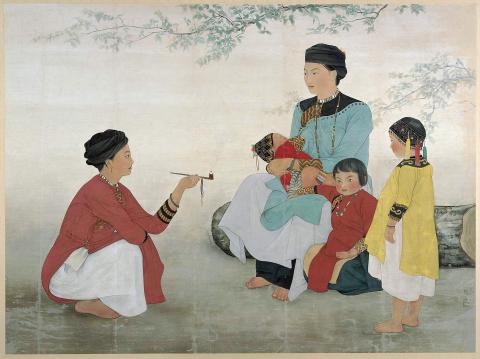
Photo: Ling Mei-hsueh, Taipei Times
According to the introduction to the 2009 exhibit, “The Three Youths of Taiwan Fine Arts Exhibition” (台展三少年), they were selected “due to their pure, fresh and realistic style of painting from [everyday] life” that broke away from traditional practices.
“These three youths used gouache, color ink and other media to express their deep personal feelings and in-depth observations regarding the scenery, personages and conditions of the people of their homeland.”
All three lived extremely long lives, with Kuo the last to pass away — in 2012 — at the age of 104. Chen painted well into the 1990s, with her subject matter continuously reflecting changes in society and her life — for example, in 1994, she completed Playing Video Games (玩電玩), which depicted her two grandsons playing Super Mario Brothers in their living room.
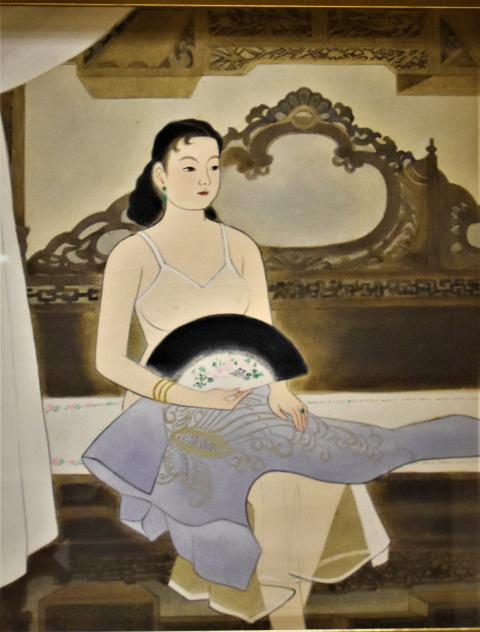
Photo courtesy of Wikimedia Commons
RISE TO FAME
Chen was born into a wealthy family in Hsinchu on Nov. 2, 1907. At the age of 15, she entered Taipei’s Third Girls High School (today’s Zhongshan Girls High School) and picked up the paintbrush for the first time. While she excelled in many subjects, it was her art teacher Gobara Koto who strongly encouraged her to pursue art. Chen’s father agreed right away.
In the spring of 1925, Chen boarded a ship bound for Japan to study at the prestigious Women’s School of Fine Arts. The Tokyo University of the Arts did not accept females until 1946.
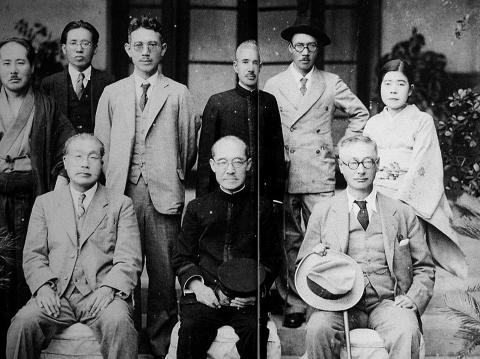
Photo courtesy of Wikimedia Commons
In those days, studying abroad was reserved for privileged families, and usually reserved for sons. It was even uncommon to study the arts — renowned painter Yang San-lang (楊三郎) had to secretly board a ship to Japan to pursue his studies. But Chen’s father fully supported her endeavors while most of her classmates got married and had children. In fact, she became the first Taiwanese woman to study art in Japan.
“I’m very fortunate to have an open-minded father, who was willing to spend any amount of money for my education,” she says. But he was also very strict, often scolding Chen for not working hard enough.
Two years later, Chen became a household name due to the media frenzy surrounding her selection to the Taiwan Fine Arts Exhibition. The established artists who were not chosen criticized the decision, and held their own “exhibit for the rejected” in the Taiwan Daily News (台灣日日新報) headquarters.
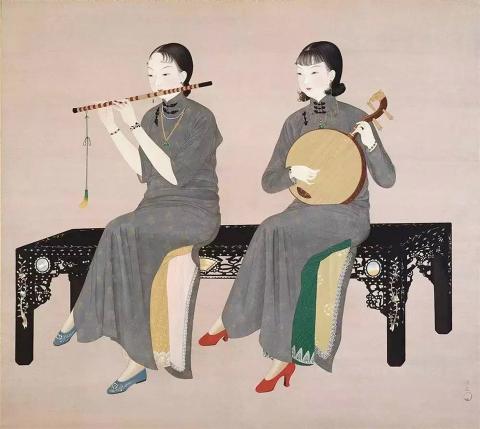
Photo: Sun Yi-fang, Taipei Times
The Fine Arts Exhibition was a government directive to steer Taiwan’s art scene away from traditional Chinese influences and toward modern and Western styles in tune with the Meiji Restoration.
“This island, which had little culture, has been under Japanese rule for 30 years and its artistic taste has greatly improved,” read an official statement.
This is the main reason why the established painters were not chosen, as the colonial government preferred young Taiwanese who were born and raised under Japanese rule. Chen continued to shine in the exhibition in the following years.
Although her artistic education was completely Japanese, her work still mostly focused on daily life of mostly upper class Taiwanese women.
Eight years later, Chen made the news again when her iconic painting Ensemble (合奏) made it into the Imperial Fine Arts Academy Exhibition in Tokyo. The two female musicians in the piece sat on distinctly Taiwanese chairs, played traditional instruments and dressed in the typical fashion of Taiwanese upper class ladies in the 1930s.
The newspapers jumped on the achievement by a young woman from a backwater colony, further bolstering her reputation. “Taiwan is a wonderful place,” she told the Japanese reporters. “Who doesn’t love the place they grew up in?”
REFLECTING THE DECADES
In 1934, Chen returned home to teach art at Pingtung Girls High School, becoming Taiwan’s first female high school teacher. She often visited the Paiwan Aborigines in the Sandimen area, resulting in her well-known Women of Sandimen (三地門之女).
When World War II broke out, Chen’s paintings also reflected the tension of the times, with one piece depicting two women reading a news article about the Japanese occupation of Hong Kong. Even so, her subjects’ expressions remained calm and graceful. After the Japanese defeat, the “Three Youths” served among the judges at the first Taiwan Provincial Fine Arts Exhibition in 1946.
Chen was so immersed in her art that she didn’t get married until the age of 40. Her son was born four years later, and her subject matter shifted toward family life.
However, as China fell to the communists in 1949, many renowned Chinese artists fled to Taiwan. Coupled with the Chinese Nationalist Party’s (KMT) promotion of Chinese culture and efforts to purge Taiwan of Japanese influence, Japanese-educated artists such as Chen quickly lost prestige. She regained her passion after a painting made it to a national exhibition in Japan, and funded her own art show at Taipei’s Zhongshan Hall in 1958.
She soon fell ill, and spent the next two years in recovery. During this time, she worked on a series of commissions by a Buddhist master, and converted to the religion when she was done. Buddhist imagery became a frequent subject in her paintings from then on.
Chen’s paintings continued to mark the significant events in her life — from her wedding night to her travels to the US, her son getting married and the birth of her first grandchild. Her Family Portrait (全家福) brings her life journey full circle, as she depicts herself as an old lady, enjoying her time with her loved ones.
Taiwan in Time, a column about Taiwan’s history that is published every Sunday, spotlights important or interesting events around the nation that ha ve anniversaries this week.

Sept. 1 to Sept. 7 In 1899, Kozaburo Hirai became the first documented Japanese to wed a Taiwanese under colonial rule. The soldier was partly motivated by the government’s policy of assimilating the Taiwanese population through intermarriage. While his friends and family disapproved and even mocked him, the marriage endured. By 1930, when his story appeared in Tales of Virtuous Deeds in Taiwan, Hirai had settled in his wife’s rural Changhua hometown, farming the land and integrating into local society. Similarly, Aiko Fujii, who married into the prominent Wufeng Lin Family (霧峰林家) in 1927, quickly learned Hoklo (commonly known as Taiwanese) and
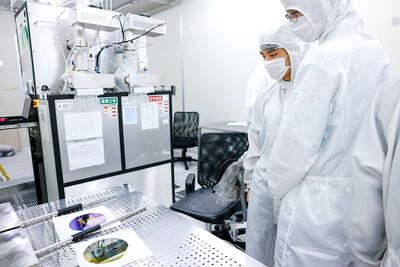
The low voter turnout for the referendum on Aug. 23 shows that many Taiwanese are apathetic about nuclear energy, but there are long-term energy stakes involved that the public needs to grasp Taiwan faces an energy trilemma: soaring AI-driven demand, pressure to cut carbon and reliance on fragile fuel imports. But the nuclear referendum on Aug. 23 showed how little this registered with voters, many of whom neither see the long game nor grasp the stakes. Volunteer referendum worker Vivian Chen (陳薇安) put it bluntly: “I’ve seen many people asking what they’re voting for when they arrive to vote. They cast their vote without even doing any research.” Imagine Taiwanese voters invited to a poker table. The bet looked simple — yes or no — yet most never showed. More than two-thirds of those
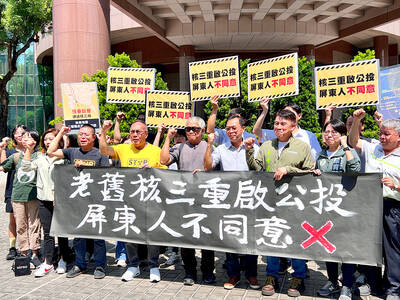
In the run-up to the referendum on re-opening Pingtung County’s Ma-anshan Nuclear Power Plant last month, the media inundated us with explainers. A favorite factoid of the international media, endlessly recycled, was that Taiwan has no energy reserves for a blockade, thus necessitating re-opening the nuclear plants. As presented by the Chinese-language CommonWealth Magazine, it runs: “According to the US Department of Commerce International Trade Administration, 97.73 percent of Taiwan’s energy is imported, and estimates are that Taiwan has only 11 days of reserves available in the event of a blockade.” This factoid is not an outright lie — that

Former Chinese Nationalist Party (KMT) chairwoman Hung Hsiu-chu’s (洪秀柱) attendance at the Chinese Communist Party’s (CPP) “Chinese People’s War of Resistance Against Japanese Aggression and the World Anti-Fascist War” parade in Beijing is infuriating, embarrassing and insulting to nearly everyone in Taiwan, and Taiwan’s friends and allies. She is also ripping off bandages and pouring salt into old wounds. In the process she managed to tie both the KMT and the Democratic Progressive Party (DPP) into uncomfortable knots. The KMT continues to honor their heroic fighters, who defended China against the invading Japanese Empire, which inflicted unimaginable horrors on the